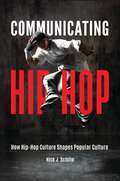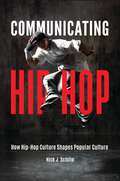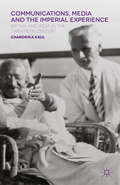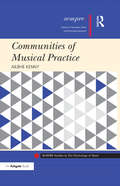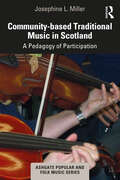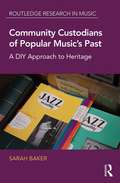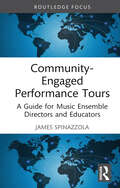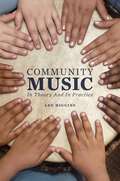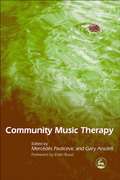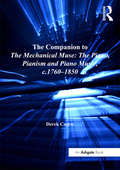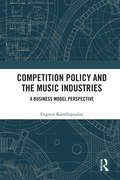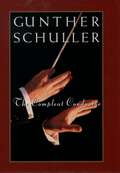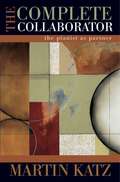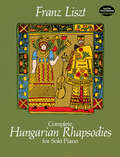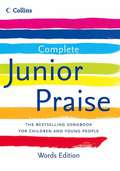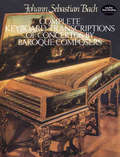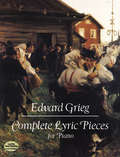- Table View
- List View
Communicating Hip-Hop: How Hip-Hop Culture Shapes Popular Culture
by Nick J. SciulloThis insightful analysis of the broad impact of hip-hop on popular culture examines the circulation of hip-hop through media, academia, business, law, and consumer culture to explain how hip-hop influences thought and action through our societal institutions.How has hip-hop influenced our culture beyond the most obvious ways (music and fashion)? Examples of the substantial power of hip-hop culture include influence on consumer buying habits—for example, Dr. Dre's Beats headphones; politics, seen in Barack Obama's election as the first "hip-hop president" and increased black political participation; and social movements such as various stop-the-violence movements and mobilization against police brutality and racism.In Communicating Hip-Hop: How Hip-Hop Culture Shapes Popular Culture, author Nick Sciullo considers hip-hop's role in shaping a number of different aspects of modern culture ranging from law to communication and from business to English studies. Each chapter takes the reader on a behind-the-scenes tour of hip-hop's importance in various areas of culture with references to leading literature and music. Intended for scholars and students of hip-hop, race, music, and communication as well as a general audience, this appealing, accessible book will enable readers to understand why hip-hop is so important and see why hip-hop has such far-reaching influence.
Communicating Hip-Hop: How Hip-Hop Culture Shapes Popular Culture
by Nick J. SciulloThis insightful analysis of the broad impact of hip-hop on popular culture examines the circulation of hip-hop through media, academia, business, law, and consumer culture to explain how hip-hop influences thought and action through our societal institutions.How has hip-hop influenced our culture beyond the most obvious ways (music and fashion)? Examples of the substantial power of hip-hop culture include influence on consumer buying habits—for example, Dr. Dre's Beats headphones; politics, seen in Barack Obama's election as the first "hip-hop president" and increased black political participation; and social movements such as various stop-the-violence movements and mobilization against police brutality and racism.In Communicating Hip-Hop: How Hip-Hop Culture Shapes Popular Culture, author Nick Sciullo considers hip-hop's role in shaping a number of different aspects of modern culture ranging from law to communication and from business to English studies. Each chapter takes the reader on a behind-the-scenes tour of hip-hop's importance in various areas of culture with references to leading literature and music. Intended for scholars and students of hip-hop, race, music, and communication as well as a general audience, this appealing, accessible book will enable readers to understand why hip-hop is so important and see why hip-hop has such far-reaching influence.
Communications, Media and the Imperial Experience: Britain and India in the Twentieth Century
by Chandrika KaulPresenting a communicational perspective on the British empire in India during the 20th century, the book seeks to examine how, and explain why, British proconsuls, civil servants and even the monarch George V, as well as Indian nationalists, interacted with the media, primarily British and American, and with what consequences.
Communities of Musical Practice (SEMPRE Studies in The Psychology of Music)
by Ailbhe KennyEvery day people come together to make music. Whether amateur or professional, young or old, jazz enthusiasts or rock stars, what is common to all of these musical groups is the potential to create communities of musical practice (CoMP). Such communities are created through practices: ways of engaging, rules, membership, roles, identities and learning that is both shared through collective musical endeavour and situated within certain sociocultural contexts. Ailbhe Kenny investigates CoMP as a rich model for community engagement, musical participation and transformation in music education. This book is the first to produce a valid and reliable in-depth study of music communities using a community of practice (CoP) framework - in this case focusing on the social process of musical learning. Employing case study research within Ireland, three illustrations from particular sociocultural, genre-specific, economic and geographical contexts are examined: an adult amateur jazz ensemble, a youth choir, and an online Irish traditional music web platform. Each case is analysed as a distinct community and phenomenon offering sharpened understandings of each sub-culture with specific findings presented for each community.
Communities of Musical Practice (SEMPRE Studies in The Psychology of Music)
by Ailbhe KennyEvery day people come together to make music. Whether amateur or professional, young or old, jazz enthusiasts or rock stars, what is common to all of these musical groups is the potential to create communities of musical practice (CoMP). Such communities are created through practices: ways of engaging, rules, membership, roles, identities and learning that is both shared through collective musical endeavour and situated within certain sociocultural contexts. Ailbhe Kenny investigates CoMP as a rich model for community engagement, musical participation and transformation in music education. This book is the first to produce a valid and reliable in-depth study of music communities using a community of practice (CoP) framework - in this case focusing on the social process of musical learning. Employing case study research within Ireland, three illustrations from particular sociocultural, genre-specific, economic and geographical contexts are examined: an adult amateur jazz ensemble, a youth choir, and an online Irish traditional music web platform. Each case is analysed as a distinct community and phenomenon offering sharpened understandings of each sub-culture with specific findings presented for each community.
Community-based Traditional Music in Scotland: A Pedagogy of Participation (Ashgate Popular and Folk Music Series)
by Josephine L. MillerThis book examines the community-based learning and teaching of ‘traditional’ music in contemporary Scotland, with implications for transnational theoretical issues. The book draws on a broad range of scholarship and a local case study of a large organisation. A historical perspective provides an overview of new educational formats emerging from the mid-twentieth century folk music revival in Scotland. Practices through which participants encounter and perpetuate the idiom of traditional music include social music-making, learning by ear and participatory and presentational elements of musical performances. Individuals are shown as combining these aspects with their own learning strategies to participate in the contemporary community of practice of traditional music. The work also discusses how experiences of learning contribute to identity formation, including the role and practice of ‘tutors’ of traditional music. The author proposes conceptualising the teaching and learning of traditional music in community-based organisations as a ‘pedagogy of participation’.
Community-based Traditional Music in Scotland: A Pedagogy of Participation (Ashgate Popular and Folk Music Series)
by Josephine L. MillerThis book examines the community-based learning and teaching of ‘traditional’ music in contemporary Scotland, with implications for transnational theoretical issues. The book draws on a broad range of scholarship and a local case study of a large organisation. A historical perspective provides an overview of new educational formats emerging from the mid-twentieth century folk music revival in Scotland. Practices through which participants encounter and perpetuate the idiom of traditional music include social music-making, learning by ear and participatory and presentational elements of musical performances. Individuals are shown as combining these aspects with their own learning strategies to participate in the contemporary community of practice of traditional music. The work also discusses how experiences of learning contribute to identity formation, including the role and practice of ‘tutors’ of traditional music. The author proposes conceptualising the teaching and learning of traditional music in community-based organisations as a ‘pedagogy of participation’.
Community Custodians of Popular Music's Past: A DIY Approach to Heritage (Routledge Research in Music)
by Sarah BakerThis book examines do-it-yourself (DIY) approaches to the collection, preservation, and display of popular music heritage being undertaken by volunteers in community archives, museums and halls of fame globally. DIY institutions of popular music heritage are much more than ‘unofficial’ versions of ‘official’ institutions; rather, they invoke a complex network of affect and sociality, and are sites where interested people – often enthusiasts – are able to assemble around shared goals related to the preservation of and ownership over the material histories of popular music culture. Drawing on interviews and observations with founders, volunteers and heritage workers in 23 DIY institutions in Australasia, Europe and North America, the book highlights the potentialities of bottom-up, community-based interventions into the archiving and preservation of popular music’s material history. It reveals the kinds of collections being housed in these archives, how they are managed and maintained, and explores their relationship to mainstream heritage institutions. The study also considers the cultural labor of volunteers in the DIY institution, arguing that while these are places concerned with heritage management and the preservation of artefacts, they are also extensions of musical communities in the present in which activities around popular music preservation have personal, cultural, community and heritage benefits. By looking at volunteers’ everyday interventions in the archiving and curating of popular music’s material past, the book highlights how DIY institutions build upon national heritage strategies at the community level and have the capacity to contribute to the democratization of popular music heritage. This book will have a broad appeal to a range of scholars in the fields of popular music studies, musicology, ethnomusicology, archive studies and archival science, museum studies, critical heritage studies, cultural studies, cultural sociology and media studies.
Community Custodians of Popular Music's Past: A DIY Approach to Heritage (Routledge Research in Music)
by Sarah BakerThis book examines do-it-yourself (DIY) approaches to the collection, preservation, and display of popular music heritage being undertaken by volunteers in community archives, museums and halls of fame globally. DIY institutions of popular music heritage are much more than ‘unofficial’ versions of ‘official’ institutions; rather, they invoke a complex network of affect and sociality, and are sites where interested people – often enthusiasts – are able to assemble around shared goals related to the preservation of and ownership over the material histories of popular music culture. Drawing on interviews and observations with founders, volunteers and heritage workers in 23 DIY institutions in Australasia, Europe and North America, the book highlights the potentialities of bottom-up, community-based interventions into the archiving and preservation of popular music’s material history. It reveals the kinds of collections being housed in these archives, how they are managed and maintained, and explores their relationship to mainstream heritage institutions. The study also considers the cultural labor of volunteers in the DIY institution, arguing that while these are places concerned with heritage management and the preservation of artefacts, they are also extensions of musical communities in the present in which activities around popular music preservation have personal, cultural, community and heritage benefits. By looking at volunteers’ everyday interventions in the archiving and curating of popular music’s material past, the book highlights how DIY institutions build upon national heritage strategies at the community level and have the capacity to contribute to the democratization of popular music heritage. This book will have a broad appeal to a range of scholars in the fields of popular music studies, musicology, ethnomusicology, archive studies and archival science, museum studies, critical heritage studies, cultural studies, cultural sociology and media studies.
Community-Engaged Performance Tours: A Guide for Music Ensemble Directors and Educators
by James SpinazzolaCommunity-Engaged Performance Tours addresses the role of performance touring as a form of classroom and community engagement. Performance tours have long been a part of the collegiate and high school music ensemble experience, bringing student bands, choirs, and orchestras into connection with a wide variety of audiences, venues, and cultural contexts. This book presents a new approach to the performance tour that integrates touring with community engagement and service-learning. Emphasizing reciprocity, cross-cultural exchange, and global awareness, the author addresses how visiting ensembles can work with host communities instead of performing for them. The book includes student and community perspectives and case studies from the author’s experience leading university wind symphony tours in Haiti and the Dominican Republic, and provides a practical and hands-on model for ensemble leaders and educators.
Community-Engaged Performance Tours: A Guide for Music Ensemble Directors and Educators
by James SpinazzolaCommunity-Engaged Performance Tours addresses the role of performance touring as a form of classroom and community engagement. Performance tours have long been a part of the collegiate and high school music ensemble experience, bringing student bands, choirs, and orchestras into connection with a wide variety of audiences, venues, and cultural contexts. This book presents a new approach to the performance tour that integrates touring with community engagement and service-learning. Emphasizing reciprocity, cross-cultural exchange, and global awareness, the author addresses how visiting ensembles can work with host communities instead of performing for them. The book includes student and community perspectives and case studies from the author’s experience leading university wind symphony tours in Haiti and the Dominican Republic, and provides a practical and hands-on model for ensemble leaders and educators.
Community Music: In Theory and In Practice
by Lee HigginsCommunity musicians move in many diverse settings, and facilitate local music activities in a wide array of community contexts including schools, hospitals, places of worship, music festivals, and prisons. Underscoring the importance of active participation and sensitivity to context, they integrate activities such as listening, improvising, inventing and performing while emphasizing equality of opportunity and fostering a diverse and welcoming environment for all. In Community Music: In Theory and in Practice, author Lee Higgins, a recognized leader in the study and advocacy of community music, investigates an interventional approach toward active music making outside of formal teaching and learning situations. Situating community music within today's wider musical landscape, Higgins guides the reader through a historical perspective on the movement and an examination of its traits of practice, and concludes with a discussion of future implications and directions for this distinctive and increasingly significant music-making discipline. The first full-length work on the subject, Community Music: In Theory and In Practice is a must-read for anyone invested in music education, music therapy, applied ethnomusicology, or community cultural development, as well as the practitioners and participants of community music activities.
Community Music Therapy
by Mercedes Pavlicevic Gary AnsdellMusic therapists from around the world working in conventional and unconventional settings have offered their contributions to this exciting new book, presenting spirited discussion and practical examples of the ways music therapy can reflect and encourage social change. From working with traumatized refugees in Berlin, care-workers and HIV/AIDS orphans in South Africa, to adults with neurological disabilities in south-east England and children in paediatric hospitals in Norway, the contributors present their global perspectives on finding new ways forward in music therapy. Reflecting on traditional approaches in addition to these newer practices, the writers offer fresh perceptions on their identity and role as music therapists, their assumptions and attitudes about how music, people and context interact, the sites and boundaries to their work, and the new possibilities for music therapy in the 21st century. As the first book on the emerging area of Community Music Therapy, this book should be an essential and exciting read for music therapists, specialists and community musicians.
Community Music Therapy (PDF)
by Gary Ansdell Mercedes PavlicevicMusic therapists from around the world working in conventional and unconventional settings have offered their contributions to this exciting new book, presenting spirited discussion and practical examples of the ways music therapy can reflect and encourage social change. From working with traumatized refugees in Berlin, care-workers and HIV/AIDS orphans in South Africa, to adults with neurological disabilities in south-east England and children in paediatric hospitals in Norway, the contributors present their global perspectives on finding new ways forward in music therapy. Reflecting on traditional approaches in addition to these newer practices, the writers offer fresh perceptions on their identity and role as music therapists, their assumptions and attitudes about how music, people and context interact, the sites and boundaries to their work, and the new possibilities for music therapy in the 21st century. As the first book on the emerging area of Community Music Therapy, this book should be an essential and exciting read for music therapists, specialists and community musicians.
The Companion to The Mechanical Muse: The Piano, Pianism and Piano Music, c.1760–1850
by Derek CarewIntended as a supplement to The Mechanical Muse: The Piano, Pianism and Piano Music, c.1760-1850, this Companion provides additional information which, largely for reasons of space but also of continuity, it was not possible or desirable to include in that volume. The book is laid out alphabetically and full biographical entries are provided for all musical figures mentioned, including composers, performers, theoreticians and teachers, as well as piano makers and publishers of music, within the period covered by The Mechanical Muse. There are also entries on figures of importance from outside the period but whose influence is palpably important within it, such as J.S. Bach. As well as biographical information, all these entries contain lists of principal works and a section on further reading so that readers can follow up people and matters of particular interest. Also included in The Companion are entries devoted to particular works and other information of relevance, such as descriptions of musical forms, characteristics of dances and so on, as well as some technical information on music and explanations of technical terms pertaining to keyboard instruments themselves and to ways of playing them. This Companion is not intended to replace existing reference books such as Grove or Musik in Geschichte und Gegenwart, but will be useful for those who desire to know more about a particular topic and do not necessarily have access to more specialist reference works, or time to visit large or specialist libraries. As such it is indispensable to users of The Mechanical Muse.
The Companion to The Mechanical Muse: The Piano, Pianism and Piano Music, c.1760–1850
by Derek CarewIntended as a supplement to The Mechanical Muse: The Piano, Pianism and Piano Music, c.1760-1850, this Companion provides additional information which, largely for reasons of space but also of continuity, it was not possible or desirable to include in that volume. The book is laid out alphabetically and full biographical entries are provided for all musical figures mentioned, including composers, performers, theoreticians and teachers, as well as piano makers and publishers of music, within the period covered by The Mechanical Muse. There are also entries on figures of importance from outside the period but whose influence is palpably important within it, such as J.S. Bach. As well as biographical information, all these entries contain lists of principal works and a section on further reading so that readers can follow up people and matters of particular interest. Also included in The Companion are entries devoted to particular works and other information of relevance, such as descriptions of musical forms, characteristics of dances and so on, as well as some technical information on music and explanations of technical terms pertaining to keyboard instruments themselves and to ways of playing them. This Companion is not intended to replace existing reference books such as Grove or Musik in Geschichte und Gegenwart, but will be useful for those who desire to know more about a particular topic and do not necessarily have access to more specialist reference works, or time to visit large or specialist libraries. As such it is indispensable to users of The Mechanical Muse.
Competition Policy and the Music Industries: A Business Model Perspective
by Jenny KanellopoulouThis book explores the nature of the music industries before and after the digital revolution from the point of view of the consumer, and explores the question of whether there is a role for competition policy intervention in the music industries. Considering the historically consolidated environment of the music industries, and their rapidly evolving business models in the 21st century, the author argues that there is a need for updated competition design to promote consumer welfare and competition in these markets. Opening a much-needed interdisciplinary dialogue across music studies, business, and law, the book applies business model literature to antitrust law in the context of the music industries. It offers a comprehensive history of encounters between the music industry and antitrust and regulatory authorities in the US, UK, and EU, from the payola scandals of the 1950s to the merger of Live Nation and Ticketmaster in 2010, showing how even as business models in the industry have changed, it has repeatedly moved toward consolidation with little regulation. Drawing on this history, it considers how competition policy can foster innovation and safeguard consumer interests in the music markets of the future. Offering new analytical and methodological tools, this book is relevant to those studying the music industries from business, legal, and cultural perspectives.
Competition Policy and the Music Industries: A Business Model Perspective
by Jenny KanellopoulouThis book explores the nature of the music industries before and after the digital revolution from the point of view of the consumer, and explores the question of whether there is a role for competition policy intervention in the music industries. Considering the historically consolidated environment of the music industries, and their rapidly evolving business models in the 21st century, the author argues that there is a need for updated competition design to promote consumer welfare and competition in these markets. Opening a much-needed interdisciplinary dialogue across music studies, business, and law, the book applies business model literature to antitrust law in the context of the music industries. It offers a comprehensive history of encounters between the music industry and antitrust and regulatory authorities in the US, UK, and EU, from the payola scandals of the 1950s to the merger of Live Nation and Ticketmaster in 2010, showing how even as business models in the industry have changed, it has repeatedly moved toward consolidation with little regulation. Drawing on this history, it considers how competition policy can foster innovation and safeguard consumer interests in the music markets of the future. Offering new analytical and methodological tools, this book is relevant to those studying the music industries from business, legal, and cultural perspectives.
The Compleat Conductor
by Gunther SchullerA world-renowned conductor and composer who has lead most of the major orchestras in North America and Europe, a talented musician who has played under the batons of such luminaries as Toscanini and Walter, and an esteemed arranger, scholar, author, and educator, Gunther Schuller is without doubt a major figure in the music world. Now, in The Compleat Conductor, Schuller has penned a highly provocative critique of modern conducting, one that is certain to stir controversy. Indeed, in these pages he castigates many of this century's most venerated conductors for using the podium to indulge their own interpretive idiosyncrasies rather than devote themselves to reproducing the composer's stated and often painstakingly detailed intentions. Contrary to the average concert-goer's notion (all too often shared by the musicians as well) that conducting is an easily learned skill, Schuller argues here that conducting is "the most demanding, musically all embracing, and complex" task in the field of music performance. Conducting demands profound musical sense, agonizing hours of study, and unbending integrity. Most important, a conductor's overriding concern must be to present a composer's work faithfully and accurately, scrupulously following the score including especially dynamics and tempo markings with utmost respect and care. Alas, Schuller finds, rare is the conductor who faithfully adheres to a composer's wishes. To document this, Schuller painstakingly compares hundreds of performances and recordings with the original scores of eight major compositions: Beethoven's fifth and seventh symphonies, Schumann's second (last movement only), Brahms's first and fourth, Tchaikovsky's sixth, Strauss's "Till Eulenspiegel" and Ravel's "Daphnis et Chloe, Second Suite." Illustrating his points with numerous musical examples, Schuller reveals exactly where conductors have done well and where they have mangled the composer's work. As he does so, he also illuminates the interpretive styles of many of our most celebrated conductors, offering pithy observations that range from blistering criticism of Leonard Bernstein ("one of the world's most histrionic and exhibitionist conductors") to effusive praise of Carlos Kleiber (who "is so unique, so remarkable, so outstanding that one can only describe him as a phenomenon"). Along the way, he debunks many of the music world's most enduring myths (such as the notion that most of Beethoven's metronome markings were "wrong" or "unplayable," or that Schumann was a poor orchestrator) and takes on the "cultish clan" of period instrument performers, observing that many of their claims are "totally spurious and chimeric." In his epilogue, Schuller sets forth clear guidelines for conductors that he believes will help steer them away from self indulgence towards the correct realization of great art. Courageous, eloquent, and brilliantly insightful, The Compleat Conductor throws down the gauntlet to conductors worldwide. It is a controversial book that the music world will be debating for many years to come.
The Compleat Conductor
by Gunther SchullerA world-renowned conductor and composer who has lead most of the major orchestras in North America and Europe, a talented musician who has played under the batons of such luminaries as Toscanini and Walter, and an esteemed arranger, scholar, author, and educator, Gunther Schuller is without doubt a major figure in the music world. Now, in The Compleat Conductor, Schuller has penned a highly provocative critique of modern conducting, one that is certain to stir controversy. Indeed, in these pages he castigates many of this century's most venerated conductors for using the podium to indulge their own interpretive idiosyncrasies rather than devote themselves to reproducing the composer's stated and often painstakingly detailed intentions. Contrary to the average concert-goer's notion (all too often shared by the musicians as well) that conducting is an easily learned skill, Schuller argues here that conducting is "the most demanding, musically all embracing, and complex" task in the field of music performance. Conducting demands profound musical sense, agonizing hours of study, and unbending integrity. Most important, a conductor's overriding concern must be to present a composer's work faithfully and accurately, scrupulously following the score including especially dynamics and tempo markings with utmost respect and care. Alas, Schuller finds, rare is the conductor who faithfully adheres to a composer's wishes. To document this, Schuller painstakingly compares hundreds of performances and recordings with the original scores of eight major compositions: Beethoven's fifth and seventh symphonies, Schumann's second (last movement only), Brahms's first and fourth, Tchaikovsky's sixth, Strauss's "Till Eulenspiegel" and Ravel's "Daphnis et Chloe, Second Suite." Illustrating his points with numerous musical examples, Schuller reveals exactly where conductors have done well and where they have mangled the composer's work. As he does so, he also illuminates the interpretive styles of many of our most celebrated conductors, offering pithy observations that range from blistering criticism of Leonard Bernstein ("one of the world's most histrionic and exhibitionist conductors") to effusive praise of Carlos Kleiber (who "is so unique, so remarkable, so outstanding that one can only describe him as a phenomenon"). Along the way, he debunks many of the music world's most enduring myths (such as the notion that most of Beethoven's metronome markings were "wrong" or "unplayable," or that Schumann was a poor orchestrator) and takes on the "cultish clan" of period instrument performers, observing that many of their claims are "totally spurious and chimeric." In his epilogue, Schuller sets forth clear guidelines for conductors that he believes will help steer them away from self indulgence towards the correct realization of great art. Courageous, eloquent, and brilliantly insightful, The Compleat Conductor throws down the gauntlet to conductors worldwide. It is a controversial book that the music world will be debating for many years to come.
The Complete Collaborator: The Pianist As Partner (pdf)
by Martin KatzTake more than forty years of partnering celebrated soloists in concerts all over the world, add nearly thirty years of teaching the art of accompanying, and you have the qualifications for such an audacious title as The Complete Collaborator. All the tools for understanding and executing first-class collaborative piano are here, paired with audio recordings of many of the musical examples performed by the author himself, along with two vocalists, on a companion website. The obvious topics: breathing, languages, flexibility, and creating a collaborative atmosphere are discussed at length, articulated clearly for the curious novice and proving beneficial even for the experienced professional. In addition, two significant chapters deal with orchestral accompaniment, reflecting today's requirements for any professional accompanist. Oft-neglected details such as beginning a piece together, telling stories with piano solos, tuning, and balance between the players are also covered herein. Dubbed the "Dean of Accompanists" by the Los Angeles Times, this teacher of sold-out masters' classes presents his material clearly and incisively, but always with the humor and wit for which he is known. Whether it be read by the curious novice, the amateur who wants to accompany as best he can, or the experienced professional seeking confirmation or a new look at the role of any partner, Martin Katz's The Complete Collaborator is all one needs.
Complete Hungarian Rhapsodies for Solo Piano
by Franz LisztUnrivaled as a virtuoso pianist in his own day -- and perhaps still -- Franz Liszt was a composer of daring originality. He introduced new conceptions of harmony and melody and made radical innovations in piano technique. In a long and prolific career, he produced over 400 works for piano -- brilliant compositions with flashes of eloquence and energy that evoke a full, rich orchestral sound. Best known and best loved are the Hungarian Rhapsodies.Reproduced directly from an authoritative Russian edition of the composer's works, this inexpensive and sturdily bound volume presents the complete Hungarian Rhapsodies for solo piano: No. 1, in C-sharp Minor; No. 2, in C-sharp Minor; No. 3, in B-flat Major; No. 4, in E-flat Major; No. 5, in E Minor; No. 6, in D-flat Major; No. 7, in D Minor; No. 8, in F-sharp Minor; No. 9 (Pester Karneval; "Carnival in Pest"), in E-flat Major; No. 10, in E Major; No. 11, in A Minor; No. 12, in C-sharp Minor; No. 13, in A Minor; No. 14, in F Minor; No. 15, (Rákóczy March), in A Minor; No. 16, in A Minor; No. 17, in D Minor; No. 18, in C-sharp Minor; and No. 19, in D Minor.This edition features English translations of all headings and footnotes that originally appeared in Russian. Published in association with the American Liszt Society, this edition offers all the quality features musicians have long associated with Dover: clear reproduction of musical notation, ample space for analysis, notes, fingerings, etc. Classical pianists, students, teachers, and lovers of music will applaud this handsome volume for playing or study -- a convenient, affordable opportunity to explore some of the great masterpieces inspired by Hungarian gypsy music.
Complete Junior Praise Words (PDF)
by Peter Horrobin Greg LeaversFor over 20 years Junior Praise has been the leading songbook in schools and Sunday schools in the UK, and around the world. Complete Junior Praise includes the whole of the existing collection of 500 songs and hymns, and adds over 100 of the best new songs from the past few years. The ultimate collection of modern songs and traditional hymns for a younger audience, Complete Junior Praise is ideal for use in a wide range of settings, from singing groups and Sunday schools to children's choirs and school assemblies. * Now with over 600 hymns and songs for every occasion* Includes all the best new songs from the past few years* Fully compatible with previous editions of Junior Praise* Easy-to-use index of first lines and titles* Words and sheet music downloads available from www. collins. co. uk
Complete Keyboard Transcriptions of Concertos by Baroque Composers (Dover Music For Piano Ser.)
by Johann Sebastian BachEarly in his career, Bach began to transcribe for the keyboard a number of concertos for violin, oboe, and other instruments by such baroque masters as Vivaldi and Telemann. His purpose: to study and explore the works of other composers as well as to supply good clavier music for his own performances.This collection of sixteen of these celebrated transcriptions is reprinted from the definitive Bach-Gesellschaft edition prepared by Ernst Naumann and presented in a study format designed to give amateur and professional pianists and harpsichordists a lifetime of pleasurable study and use.Six of these glorious keyboard works are known to be transcriptions of Vivaldi violin concertos. Three are based on concertos written by Duke Johann Ernst of Saxe-Weimar, the son of Bach's employer at Weimar. One is based on a violin concerto by Telemann, another on an oboe concerto by Alessandro Marcello, and another on a concerto by Benedetto Marcello. The sources of the remaining works are unknown.Vivaldi, whose music Bach probably first heard in 1712, was to provide a strong influence on the young composer. Bach would eventually assimilate the Italian's style and use it with his own contrapuntal heritage and the Northern idiom in creating what we recognize today as the typical Bach style. These transcriptions, which represent his introduction to the new idiom, richly display a dynamic virtuosity that makes their performance an exhilarating experience.
Complete Lyric Pieces for Piano (Dover Music For Piano Ser.)
by Edvard GriegBetween 1867 and 1901, Edvard Grieg (1843–1907) wrote ten sets of little mood pictures for piano that display his great musical gifts at their lyrical best. Charming works of elegant simplicity and warmth, they have become cornerstones of the piano repertoire, favorites of both amateur and professional musicians and their audiences.This authoritative edition presents all 66 of these piano jewels in one finely made yet inexpensive volume. Although technically uncomplicated and reasonably easy to master, the Lyric Pieces evoke with startling freshness a wide emotional range, often bringing into play the varied moods and idioms of Norwegian folk music, an evergreen source of Grieg's inspiration. They vary in mood from the serene sadness of "Berceuse" and the nostalgic yearning of "To Spring" to the fanciful "Elves' Dance" and the joyful "Wedding Day at Troldhaugen."In many passages, the music exhibits harmonies that were novel for the time — harmonies recognizably late-romantic in style, but clearly anticipating the impressionism of Debussy, Ravel, and others. Pianists at every level of accomplishment will find this volume of delightful and moving works, reprinted here from the original editions published by C. F. Peters of Leipzig, a perfect companion for hours of musical pleasure.
